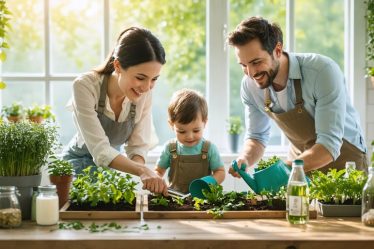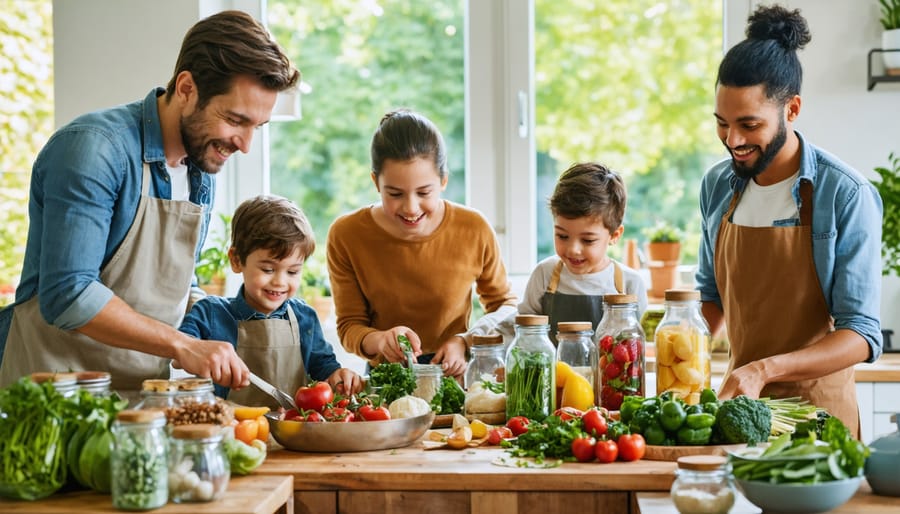
Transform your family’s daily routines into powerful habits that create lasting positive change. In today’s fast-paced world, establishing strong family practices isn’t just about survival—it’s about thriving together while building a legacy of intentional living and sustainable home solutions.
Imagine your household running like a well-oiled machine, where everyone contributes meaningfully, communicates effectively, and grows together purposefully. Whether you’re juggling career demands, managing multiple schedules, or simply seeking to strengthen your family bonds, these seven habits will help you create the harmonious family life you’ve always envisioned.
From morning routines that set the tone for successful days to evening practices that foster deep connections, these proven strategies have helped countless families transition from chaos to calm, from disconnection to unity. The best part? These habits are adaptable to families of all sizes, ages, and lifestyles, making them perfect for your unique situation.
Let’s explore how these seven transformative habits can help your family thrive while building a stronger, more connected household—starting today.
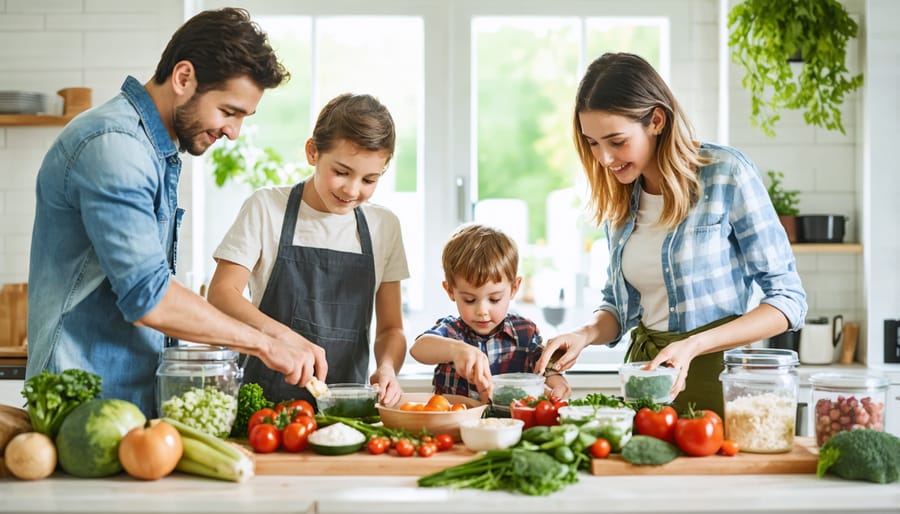
Start With Mindful Meal Planning
Weekly Meal Prep Magic
Transform your kitchen into a sustainability hub with smart meal prep strategies that benefit both your family and the planet. I discovered that dedicating just two hours every Sunday to meal planning saves us countless hours during the week while significantly reducing our food packaging waste.
Start by investing in a set of high-quality, reusable containers for storing prepped ingredients and meals. My family’s game-changer was switching to glass containers – they’re perfect for both storage and reheating, eliminating the need for disposable containers or plastic wrap.
Create a weekly menu based on seasonal produce and plan overlapping ingredients to minimize waste. For instance, if you’re chopping vegetables for Monday’s stir-fry, prep extra for Wednesday’s pasta sauce. Store prepared ingredients in clear containers at eye level in your fridge – this makes assembly quick and ensures nothing gets forgotten in the back.
Consider batch cooking basics like grains, legumes, and roasted vegetables. These versatile ingredients can be mixed and matched throughout the week, making mealtime assembly a breeze while keeping packaging waste to a minimum.
Zero-Waste Kitchen Hacks
Creating a zero-waste kitchen doesn’t have to be overwhelming. Start by storing produce properly to extend its life – keep herbs fresh in water like flowers, and use breathable produce bags for vegetables. Transform veggie scraps into a flavorful stock by collecting them in a freezer bag until you have enough for a pot of homemade broth.
Get creative with leftovers! Those browning bananas can become delicious muffins, while stale bread transforms into croutons or breadcrumbs. I learned this trick from my grandmother: citrus peels can be dried and used for tea or natural cleaning solutions.
Invest in reusable alternatives like beeswax wraps instead of plastic wrap, and cloth napkins rather than paper towels. Keep a collection of glass jars for storing bulk items and leftovers – those pasta sauce jars work perfectly! Consider starting a small compost bin for unavoidable food scraps.
Remember, small changes add up. Our family reduced our kitchen waste by 70% just by implementing these simple swaps over time. The best part? Many of these changes actually save money while helping the planet.
Create Natural Beauty Routines
DIY Family-Safe Products
Creating your own household products isn’t just budget-friendly – it’s a wonderful way to ensure your family uses safe, natural ingredients. In our home, we switched to homemade cleaners after my youngest developed sensitive skin, and we’ve never looked back!
Start with a simple all-purpose cleaner by mixing equal parts white vinegar and water, adding a few drops of lemon essential oil for a fresh scent. For a natural air freshener, simmer cinnamon sticks, cloves, and orange peels in water on your stovetop.
Our family favorite is our homemade laundry detergent: combine one cup of borax, one cup of washing soda, and one grated bar of castile soap. It’s gentle on clothes and skin while being tough on stains.
For personal care, try making a gentle body scrub by mixing brown sugar with coconut oil and a dash of vanilla extract. A simple face toner can be made by steeping green tea and allowing it to cool – perfect for sensitive skin!
Remember to label all your DIY products clearly and keep them out of children’s reach, even though they’re natural.
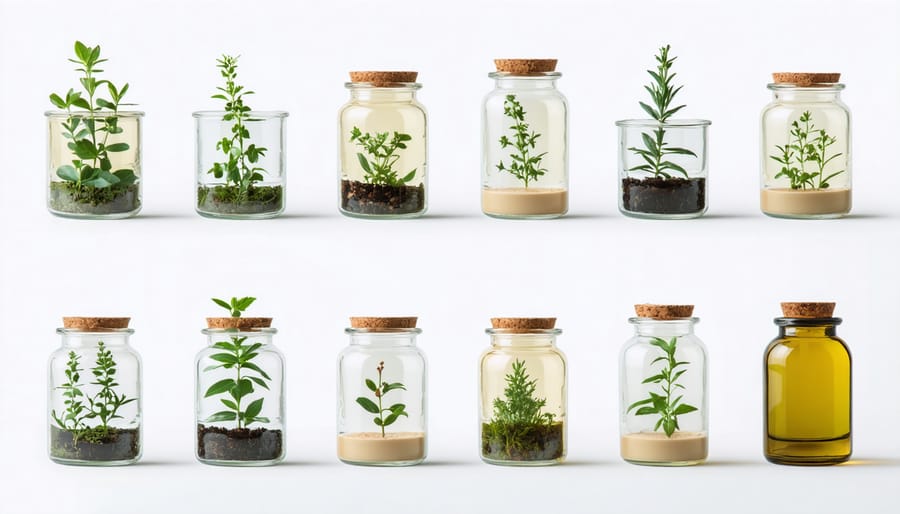
Minimal Waste Beauty Tips
Looking good doesn’t have to cost the Earth! Start by switching to plastic-free alternatives like shampoo bars and solid conditioners – they last longer and eliminate plastic bottles. Consider investing in reusable makeup removal pads made from bamboo or organic cotton instead of disposable wipes. When shopping for cosmetics, opt for brands that offer refill programs or use minimal packaging.
Create your own beauty treatments using kitchen ingredients like honey masks or coffee scrubs, which not only reduce packaging waste but are also gentle on your skin. For daily routines, try multi-purpose products like tinted moisturizers with SPF to minimize the number of products you need. Store products in clear sight to avoid forgetting about them and letting them expire.
Keep a small container to collect those last drops of product – you’d be amazed how many extra uses you can get! When you do need to dispose of beauty items, check if your local recycling program accepts cosmetic packaging, or look into specialized recycling programs offered by many beauty brands. Remember, small changes in your beauty routine can add up to significant waste reduction over time.
Establish Energy-Saving Habits
Let me share a game-changer that transformed our family’s relationship with energy consumption: turning energy-saving into a fun family activity. Just like other eco-friendly parenting hacks, these habits can make a real difference in both your utility bills and environmental impact.
Start by creating an “energy patrol” with your kids. Give them special badges and make them responsible for spotting energy waste, like lights left on in empty rooms or devices plugged in unnecessarily. My daughter loves being our household’s official “light monitor,” and it’s amazing how quickly these habits become second nature.
Make it a family ritual to do an evening energy check before bedtime. Walk through your home together, unplugging non-essential devices and ensuring everything’s properly shut down. We call it our “goodnight house” routine, and it’s become as natural as brushing teeth.
Consider setting up a reward system for energy-saving achievements. Track your monthly energy bills and celebrate when you see improvements. You might put the savings toward a family activity or eco-friendly purchase, making the connection between conservation and rewards tangible for everyone.
Simple changes like using natural light during the day, hanging clothes to dry when possible, and adjusting your thermostat by just a few degrees can make a significant impact. We found that setting our thermostat two degrees lower in winter and wearing cozy sweaters actually made our home feel more comfortable and welcoming.
Remember, the goal isn’t perfection but progress. Each small action adds up to meaningful change, and when children learn these habits early, they carry them forward into their own lives.
Practice Conscious Consumption
As a mom of three, I’ve learned that mindful consumption isn’t just about saving money – it’s about creating a more sustainable future for our children. The journey toward raising eco-conscious kids starts with our own shopping habits.
Begin by creating a detailed shopping list before heading to the store, and stick to it! This simple practice prevents impulse purchases and reduces food waste. I love involving my kids in meal planning – they’re more likely to eat what they help choose, and it teaches them valuable planning skills.
Consider implementing a 24-hour “pause period” before making non-essential purchases. This helps distinguish between wants and needs while teaching children the value of thoughtful decision-making. When you do shop, opt for quality items that last longer, even if they cost a bit more upfront.
Reduce household waste by choosing products with minimal packaging and bringing reusable bags, containers, and produce mesh bags to the store. Make it fun for kids by letting them be the family’s “packaging police” – they’ll love pointing out excessive plastic wrapping!
Start a home composting system for food scraps and garden waste. It’s amazing how much this reduces your garbage output, plus it creates rich soil for your garden. Keep a designated spot for items that can be donated, repaired, or repurposed, showing children that “trash” often has potential for a second life.
Remember, conscious consumption isn’t about perfection – it’s about progress. Celebrate small wins with your family, and watch as mindful shopping becomes second nature for everyone.
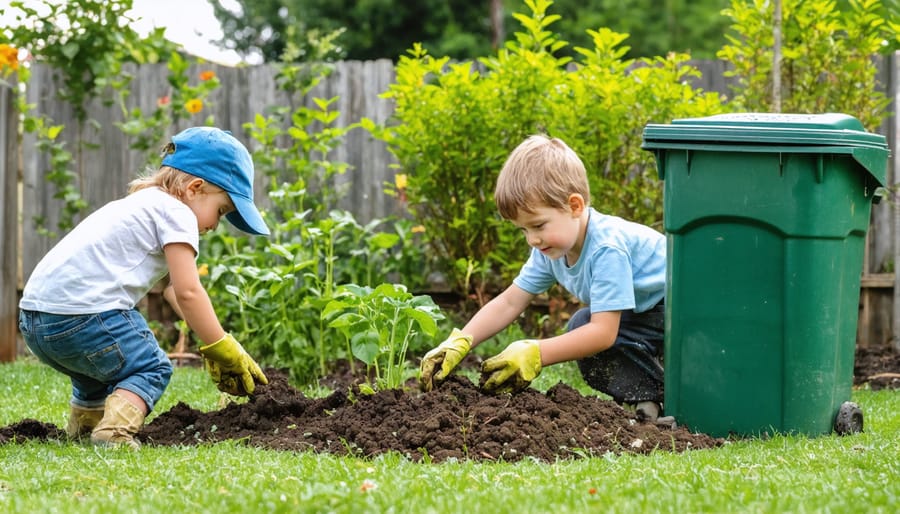
Teach Kids Environmental Values
Teaching our children about environmental responsibility doesn’t have to feel like a lecture. As parents, we can make sustainability fun and natural by weaving eco-friendly practices into our daily routines. Just like establishing mindful parenting habits, nurturing environmental values starts with small, consistent actions.
Start by involving kids in simple recycling activities – make it a game by creating colorful sorting bins and celebrating when they get it right. In our family, we turned it into a weekly challenge, and my youngest now proudly calls herself the “recycling detective.”
Get your children excited about gardening by giving them their own small plot or container. Whether it’s herbs on a windowsill or vegetables in the backyard, watching their plants grow teaches patience and connection to nature. My daughter still beams with pride when we use “her” basil in our family meals.
Make water conservation fun by setting a timer for shorter showers or creating a reward system for remembering to turn off taps. You can also encourage creativity by crafting art from recyclable materials or starting a compost bin to watch food scraps transform into garden gold.
For older children, involve them in meal planning and grocery shopping with a focus on reducing food waste. Let them help choose reusable containers for school lunches and participate in selecting plastic-free alternatives at the store.
Remember, children learn best through example. When they see us making conscious environmental choices, from bringing reusable bags to the store to fixing things instead of replacing them, they naturally adopt these values as their own.
Build Community Connections
Building connections with like-minded families not only enriches your sustainable journey but also creates a support system that makes eco-friendly living more achievable and enjoyable. I’ve found that starting small, perhaps by organizing a neighborhood clothing swap or setting up a toy-sharing circle, can lead to lasting friendships and shared resources.
Consider joining or starting a local parents’ group focused on sustainable living. These gatherings can become wonderful opportunities to exchange tips, share experiences, and even coordinate bulk purchases of eco-friendly products to reduce costs and packaging waste. In our community, we’ve created a shared garden space where families take turns tending to the plots and share the harvest, teaching our children valuable lessons about food production and community cooperation.
Digital platforms can also help you connect with sustainability-minded families. Local Facebook groups and apps like NextDoor often feature discussions about composting, recycling, and eco-friendly practices specific to your area. Don’t hesitate to initiate conversations or ask questions – you’ll be surprised how many families are eager to share their knowledge and resources.
Libraries and community centers frequently host environmental education programs and workshops perfect for family participation. These events not only provide learning opportunities but also create natural settings for meeting other families who share your values. Consider volunteering at local environmental clean-up events or joining a community garden – these activities often attract families with similar interests and goals.
Remember, building community connections isn’t just about sharing resources; it’s about creating a network of support that makes sustainable living feel more accessible and enjoyable for everyone involved.
Building sustainable habits as a family isn’t just about making eco-friendly choices – it’s about creating a legacy of conscious living that will benefit generations to come. As we’ve explored throughout this guide, implementing these seven habits doesn’t require a complete lifestyle overhaul. Instead, it’s about making small, consistent changes that add up to significant impact.
Remember, every family’s journey toward sustainability looks different, and that’s perfectly okay. Start with the habits that feel most manageable for your household, whether that’s meal planning to reduce food waste or establishing a regular recycling routine. As these practices become second nature, you can gradually incorporate more challenging habits into your family’s routine.
The beauty of adopting these habits as a family unit lies in the shared responsibility and mutual encouragement. When children see their parents actively participating in sustainable practices, they’re more likely to carry these values into their adult lives. Plus, working together towards environmental goals strengthens family bonds and creates meaningful conversations about our role in protecting the planet.
Don’t feel pressured to perfect all seven habits at once. Start with one or two that resonate most with your family’s current lifestyle and values. Celebrate small victories, learn from setbacks, and remember that every sustainable choice, no matter how small, contributes to a healthier planet for future generations.
Are you ready to begin your family’s sustainable journey? The perfect time to start is now.

